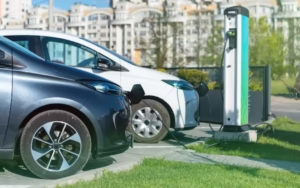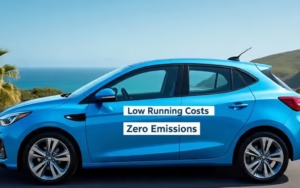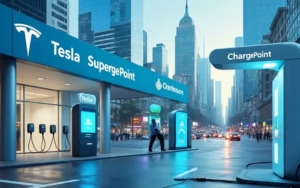In recent years, Electric Vehicle Innovations in Australia have transformed the nation’s transportation landscape. From advanced battery systems to expansive charging networks, Australians are witnessing a rapid evolution in how vehicles are powered. The push towards sustainable transportation in Australia is no longer a future goal but a present-day reality. With the growing demand for electric cars in Australia, automakers, tech companies, and government bodies are collaborating to build a cleaner, greener transport sector.
This article explores the major Electric Vehicle Innovations in Australia, highlighting the trends, technologies, and strategies shaping the EV market. We will also discuss how EV technology in Australia is making electric cars more accessible, efficient, and sustainable for all Australians.
The Growth of Electric Cars in Australia
The automotive industry is witnessing a historic shift, and Electric Vehicle Innovations in Australia are at the heart of this transformation. Over the last few years, there has been a significant rise in the sales of electric cars in Australia, showing that public interest in cleaner, greener transport is growing rapidly. In 2023 alone, EV sales more than doubled compared to the previous year, marking a turning point for the Australian vehicle market.
One of the primary reasons for this surge is the increasing affordability of EVs. As technology advances and production costs decrease, Australians are gaining access to a wider variety of electric cars at more competitive prices. Brands like BYD and MG have introduced affordable models that cater to everyday drivers, while premium options from Tesla and BMW continue to attract luxury buyers. This variety has made electric cars in Australia appealing to a broader demographic.
Additionally, the environmental consciousness of Australian consumers is rising. Many Australians are now aware of the impact of traditional petrol and diesel vehicles on the environment. This awareness has encouraged them to explore sustainable transportation in Australia, and EVs are the logical next step. Lower maintenance costs, government rebates, and the desire to reduce carbon footprints are also contributing factors.
Moreover, fleet operators and large businesses are beginning to replace their petrol-powered cars with electric models. This transition is helping normalise EV technology in Australia, bringing electric vehicles into everyday use in sectors like deliveries, public transport, and logistics.
With strong consumer demand, supportive policies, and rapid technological advances, the growth of electric cars in Australia is set to continue, pushing forward a future where zero-emission transport becomes the norm.
Battery Technology: The Heart of Electric Vehicle Innovations in Australia
At the core of Electric Vehicle Innovations in Australia is battery technology. Batteries are the most crucial component of any EV because they determine how far the car can travel on a single charge, how long it takes to recharge, and how safe the vehicle is overall. Improving battery technology is key to making electric cars in Australia more practical and efficient for everyday use.
Australian universities, startups, and research centres are playing a vital role in advancing EV technology in Australia. Researchers are working on next-generation batteries, such as solid-state batteries, which are safer and offer greater energy density than the current lithium-ion versions. These innovations can dramatically increase the range of EVs while reducing the risk of overheating or fire.
One exciting development is the exploration of graphene aluminium-ion batteries. Companies like Graphene Manufacturing Group in Brisbane are pioneering this technology, which could allow EVs to charge in just a few minutes instead of hours. This could eliminate one of the biggest barriers to EV adoption—charging time.
Battery recycling is another area of focus within Electric Vehicle Innovations in Australia. As more electric vehicles enter the market, there is a growing need for sustainable solutions to handle old EV batteries. Australian companies are investing in recycling plants that can recover valuable materials like lithium, nickel, and cobalt, reducing the need for mining and minimising environmental impact.
Overall, battery innovation is driving the progress of sustainable transportation in Australia. By developing lighter, faster-charging, and longer-lasting batteries, Australia is ensuring its place at the forefront of global EV technology.
Expanding EV Charging Infrastructure in Australia
One of the main challenges for Electric Vehicle Innovations in Australia is creating a reliable and accessible EV charging infrastructure. Without enough charging stations, many drivers hesitate to switch from petrol or diesel vehicles to electric cars. Fortunately, Australia is making huge strides in expanding its charging network to support the growing number of EVs on the road.
Leading private companies like Chargefox and Evie Networks are building fast-charging stations across the country. These chargers can refill most EV batteries up to 80 percent in under 20 minutes, making long-distance travel more convenient. New installations are appearing at shopping centres, car parks, highways, and even remote regional towns to eliminate “range anxiety.”
The Queensland Electric Super Highway is one of the most ambitious EV charging projects in the country. It provides fast-charging stations along the entire Queensland coast, enabling drivers to travel long distances with ease. Similar projects are underway in New South Wales, Victoria, and Western Australia, where state governments are partnering with private companies to expand the charging infrastructure in Australia.
Additionally, home charging solutions are becoming more accessible. Many Australians are now installing solar-powered EV chargers in their garages, allowing them to charge their cars directly from their rooftop solar panels. This innovation aligns with the broader goal of sustainable transportation in Australia, reducing reliance on the grid and promoting renewable energy use.
As more Electric Vehicle Innovations in Australia emerge, the country’s charging infrastructure will continue to grow, supporting the transition to clean, electric mobility for all Australians.

Government Policies Supporting Electric Vehicle Innovations in Australia
Government support is a crucial driver of Electric Vehicle Innovations in Australia. Without financial incentives and supportive policies, many Australians would find it difficult to afford the initial costs of switching to electric vehicles. Fortunately, both federal and state governments are actively promoting sustainable transportation in Australia through a range of programs.
At the federal level, the National Electric Vehicle Strategy outlines the government’s commitment to reducing transport emissions and supporting the rollout of EVs nationwide. Tax incentives, such as Fringe Benefits Tax (FBT) exemptions for electric company cars, are making EVs more attractive to businesses.
State governments are also providing various rebates and grants. For example:
- New South Wales offers up to $3,000 in EV rebates and stamp duty exemptions for new electric vehicle purchases.
- Victoria provides subsidies of up to $4,000 for eligible EV buyers, along with support for installing home charging stations.
- South Australia has introduced similar rebate schemes to promote the adoption of electric cars in Australia.
Local councils are playing a role by adding EVs to their own fleets and installing public charging stations. This creates visibility and normalises EV technology in Australia as a practical option for everyday use.
Beyond financial support, governments are also investing in research and development. Grants are available for Australian startups and research institutions working on EV-related projects, including battery recycling, charging infrastructure, and autonomous driving technology.
By continuing to implement strong policies and incentives, governments at all levels are ensuring that Electric Vehicle Innovations in Australia remain a central part of the country’s strategy for a cleaner, more sustainable future.
Local Manufacturing and EV Production in Australia
As part of the ongoing Electric Vehicle Innovations in Australia, local production and assembly of EVs are starting to gain traction. Companies like SEA Electric are manufacturing electric trucks and vans within Australia, creating jobs and reducing the country’s reliance on imported vehicles.
The push for EV technology in Australia also includes developing parts of the supply chain, such as battery components and software development. This local focus helps build a more resilient EV industry while supporting economic growth.
Local Manufacturing and EV Production in Australia
A significant part of Electric Vehicle Innovations in Australia involves boosting local manufacturing and EV production. While Australia has traditionally relied on car imports, there is now a shift toward developing a homegrown EV industry. This move supports the national economy, reduces supply chain risks, and creates new job opportunities in the green technology sector.
Companies like SEA Electric, headquartered in Melbourne, are leading this change by building electric trucks, vans, and commercial vehicles right here in Australia. SEA Electric converts conventional vehicles into fully electric models, offering businesses sustainable solutions for logistics and transport. This reduces fuel costs, lowers emissions, and provides quieter, cleaner delivery options in cities and suburbs.
The rise of local battery production is another area of growth within Electric Vehicle Innovations in Australia. Mining companies are extracting essential materials such as lithium, nickel, and cobalt from Australia’s rich natural reserves. These materials are then used to create battery cells domestically, helping to establish a local supply chain for EV components. By keeping more of the production process within Australia, the country reduces its reliance on overseas manufacturers and strengthens its position in the global EV market.
In addition to vehicles and batteries, Australian companies are also developing EV charging infrastructure and software systems. Innovative startups are creating apps that help drivers locate charging stations, monitor battery health, and integrate EV charging with renewable energy at home.
With growing investments in EV technology in Australia, local manufacturing is set to play a bigger role in the coming years. This will help build a sustainable economy while supporting the shift to electric cars in Australia.
Innovative EV Models Entering the Australian Market
One of the most exciting aspects of Electric Vehicle Innovations in Australia is the variety of new EV models now available. Australians no longer have to settle for limited options when choosing an electric car. Today, the market offers a diverse range of models designed to suit different needs, budgets, and lifestyles.
For city drivers, compact electric cars like the MG4 Electric and the BYD Dolphin provide affordable and practical options. These small EVs are perfect for daily commutes, with easy parking, low running costs, and minimal maintenance.
For families or those needing more space, mid-sized SUVs like the Hyundai Ioniq 5, Kia EV6, and Tesla Model Y are gaining popularity. These models offer long driving ranges, fast charging capabilities, and advanced safety features, making them suitable for both city and regional driving.
Luxury and performance EVs are also entering the Australian market. Brands like BMW, Audi, and Mercedes-Benz have introduced high-end electric models that combine sustainability with luxury and cutting-edge technology. Cars like the Polestar 2 and Tesla Model S are redefining what it means to drive an electric vehicle, proving that EVs can be both eco-friendly and exciting to drive.
The arrival of electric utes and four-wheel drives is another major development in Electric Vehicle Innovations in Australia. Companies are designing rugged electric vehicles suited for rural areas and off-road conditions, addressing the unique needs of Australian drivers who rely on utes for work and recreation.
By expanding the range of available electric cars in Australia, manufacturers are breaking down barriers to EV adoption. Whether you are a city commuter, a family driver, or an adventure seeker, there is now an electric vehicle option that fits your lifestyle.
The Role of Renewable Energy in EV Charging
A key factor in the success of Electric Vehicle Innovations in Australia is how electric cars are charged. Charging EVs with electricity from coal or gas power plants can still produce emissions. That is why Australia is focusing on linking EV charging with renewable energy sources, such as solar and wind, to create truly clean transportation solutions.
Many Australians are now installing solar-powered EV chargers at home. This allows drivers to charge their vehicles directly from rooftop solar panels during the day. By doing so, they reduce their reliance on the grid and avoid the high costs of electricity during peak hours. This is especially important in Australia, where abundant sunshine makes solar power one of the most practical and cost-effective energy solutions.
Some businesses and shopping centres are also offering solar-powered public charging stations. These stations often include solar canopies that generate clean electricity while providing shade for parked vehicles. This innovative approach aligns perfectly with the broader goals of sustainable transportation in Australia.
Large-scale renewable energy projects are being developed to support EV charging on a bigger scale. Wind farms, solar farms, and battery storage systems are being integrated with EV charging infrastructure to ensure that the growing demand for electricity is met sustainably. Companies like Origin Energy and AGL are exploring partnerships that link EV charging services directly to renewable energy production, helping to cut emissions across the entire transportation network.
In the future, technologies such as vehicle-to-grid (V2G) systems could allow electric vehicles to store excess renewable energy and return it to the grid when needed. This creates a circular energy system where EVs become not just vehicles but mobile power storage units.
By combining Electric Vehicle Innovations in Australia with renewable energy, the country is taking major steps toward reducing emissions and building a greener, cleaner future.
Electric Vehicle Fleet Adoption in Australia
Another key area of Electric Vehicle Innovations in Australia is the adoption of EVs in business and government fleets. Companies are switching to electric delivery vans, taxis, and service vehicles to reduce their operating costs and meet environmental targets.
Large organisations like Australia Post and major logistics companies have started to transition their fleets to electric, helping normalise electric cars in Australia as practical commercial solutions. This shift also helps build the second-hand EV market, making affordable used EVs available to more Australians in the future.
Smart Charging and Vehicle-to-Grid Technology
One of the latest Electric Vehicle Innovations in Australia is the development of smart charging and vehicle-to-grid (V2G) technology. Smart chargers allow drivers to schedule charging during off-peak electricity hours, saving money and reducing strain on the power grid.
With vehicle-to-grid capabilities, EVs can even send unused electricity back to the grid, acting as mobile energy storage units. This innovation is particularly important for balancing renewable energy supply, making EV technology in Australia an integral part of the future energy system.
Environmental Benefits of Electric Vehicles in Australia
The shift towards Electric Vehicle Innovations in Australia offers significant environmental advantages. By replacing petrol and diesel cars with electric alternatives, Australia can reduce greenhouse gas emissions, air pollution, and noise in urban areas.
EVs also require less maintenance because they have fewer moving parts, resulting in lower lifetime environmental impact. Combined with renewable energy charging, electric cars in Australia present one of the best solutions for combating climate change and promoting sustainable transportation in Australia.
Overcoming Challenges: The Road Ahead
Despite the progress in Electric Vehicle Innovations in Australia, there are still challenges to address. Some of the main obstacles include:
- Limited charging stations in remote areas
- Upfront costs of EVs still higher than traditional cars
- Battery recycling and disposal concerns
- Consumer education and awareness gaps
However, with continued investment in EV technology in Australia, these challenges are being steadily overcome. Both private and public sectors are working together to ensure that the future of transportation is clean, accessible, and innovative.
Conclusion: The Future of Electric Vehicle Innovations in Australia
The future of Electric Vehicle Innovations in Australia is incredibly promising. From cutting-edge battery developments to expanded charging networks, Australia is embracing the shift towards clean and sustainable transportation.
As more Australians choose electric cars, the momentum for green mobility will only grow. Government incentives, local production, and new technological breakthroughs will continue to drive progress.
By staying committed to Electric Vehicle Innovations in Australia, the nation is not just keeping up with global trends but actively shaping the next generation of transportation for a cleaner, healthier, and more energy-efficient world.






